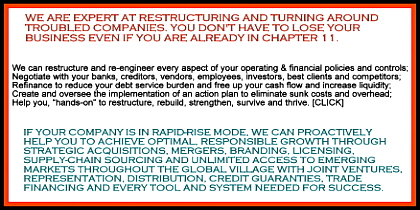After the fall of LEHMAN BROTHERS.
Douglas Castle's Note: Dr. Franco Oboni, and his son, Cesar Oboni, are world-acclaimed risk evaluation and assessment consultants. The scope of their work is international, and involves analyses of virtually every possible avenue of business risk...from geological and political events, to commodity supplies and prices, to changing technology. Notably, one of their first functions should be obvious, but is not: Identify the areas of possible risk which need to be addressed.
As the Author of The Global Futurist, The Internationalist Page, GICBC and Braintenance Blogs, an ardent fan of Dr. Oboni's, and as the frequent editor of his articles, I believe that every business decision should be based upon its promise of possible profit (alliteration there, Beth Barany!) -- but I understand that risks need to be identified, and that pre-emptive contingency planning or risk mitigation, as appropriate, are a crucial component of good business decision making. When large institutions with substantial credit lines (or investor capital) "roll the dice" based upon an unexamined but seemingly promising idea [remember "derivatives], catastrophic failure, as in the case of the late, great Lehman Brothers, is inevitable.
When these failures are concealed, and when further gambling is undertaken to "win back" the lost stake, the problem is deferred, but compounded....and with tremendous interest. When we either neglect to examine the reason for these failures, or we seek means of subsidizing the very systems and controls, the status quo that made them occur, we encourage more of the same, exponentialize their "contagion" factor, and wind up in a state of utter economic chaos. Some interesting and recent revelations about the concealment of Lehman Brothers failure to address serious errors of judgment or to take immediate corrective action follow Dr. Oboni's article.
-- Douglas Castle, Strategic Planner and Organizational Engineer. ####
Do we change our prediction?
First of all, let's make it clear that we will not delve into endless theoretical or rhetorical discussions bearing on “is this recession now finished?" - or- "Are we going to have a 'double dip'?" - or - "Are we still in the same recession”? [by "double dip," we mean the backlash of inflation and interest rates due o the government's taking of certain actions (actually, reactions) to the crisis which first came to light upon the announcement of the collapse of Lehman Brothers.]
These would be, in our minds, futile and academic discussions, based upon semantics. We are interested in knowing when we will be out of it and care very little to know if there will be another up and down, or more in the way.
Furthermore, remember that our prediction is not a financial prediction, but a more general one, as explained in the prior Parts in this Series, and the parameters that we are looking at do not have the same volatility than indexes like the Dow-Jones. The DJ may go up and down 10% per day, but unemployment and consumers' well-being take longer to change and are of much greater significance in both the short and longer-run....
It is quite obvious that the data we are analyzing these days do not lead us, for the moment, to change our prediction of calamity. If anything, some of these short-term volatile stistics actually point out to a possibly longer and more painful solution to the situation than we had originally forecast.
-- Dr. Franco Oboni
_______________________________
Douglas Castle's Note: Some interesting revelations about the fall of the "Too Big To Fail" House of Lehman follow, courtesy of Yahoo News! and The New York Times. Please read the green print carefully (it's difficult to see), and note the trend.
Report Shows How, Collapsing, Lehman Hid Woes
It is the Wall Street equivalent of a coroner's report -- a 2,200-page document that lays out, in new and startling detail, how Lehman Brothers used accounting sleight of hand to conceal the bad investments that led to its undoing... (Click to read this story).
For more information, please visit Franco's TNNW Bio.
Forward/Share This Article With Colleagues And Social Media:









